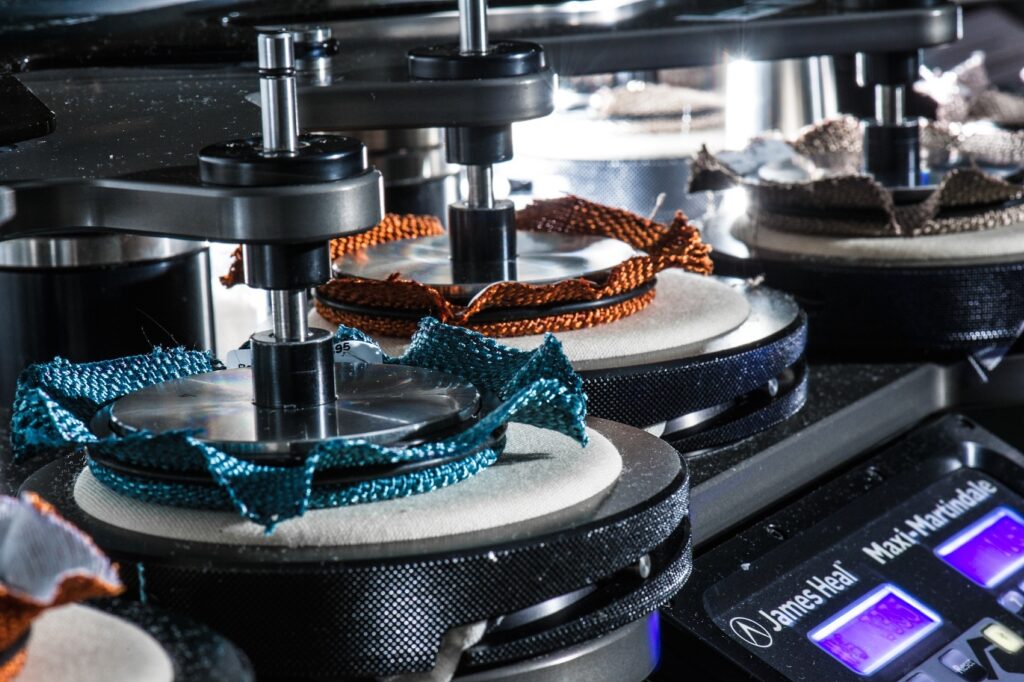Abrasion testing for performance fabrics: explaining Martindale and Wyzenbeek
When it comes to assessing the durability of upholstery materials, Wyzenbeek and Martindale abrasion textiles tests are two of the most widely used methods. Both textile tests are effective ways to measure the durability of fabrics and knowing the results of these tests can help you make an informed decision when selecting fabrics for your home or business.
What are the Wyzenbeek (ASTM D4157) and Martindale (EN 14465) abrasion tests?
Both Wyzenbeek and Martindale are abrasion textiles tests, which measure how well a material can withstand wear without breaking down. It’s still important to remember that these tests measure only the abrasion resistance of fabrics, not their overall durability. To get a true sense of a fabric's overall durability, additional tests may be needed.
Although the two tests have similar outcomes (a good score means that your finished product will last longer), they test different aspects of its performance.
Just because your fabric sample performs well in one test doesn’t mean it’ll perform equally well in the other.
What’s the difference?
The differences and similarities of the Martindale and Wyzenbeek abrasion tests
The Wyzenbeek abrasion test is generally used in North America, and the Martindale test is used elsewhere around the globe. Another difference between the two tests is the way they rub the fabric once it’s in the chamber.
How the tests work:
The Wyzenbeek test rubs along the warp and weft of a fabric whereas the Martindale method involves rubbing in a figure-8 pattern. The fabric sample is assessed at certain intervals to identify yarn breakages and appearance changes (example: loss of pile or pilling). The higher the number of rubs a fabric sample can withstand, the better the upholstery will hold up over time, especially if you have kids or pets who tend to scratch up furniture.
We asked one of the Labotex team members how many rubs can a fabric take before there are signs of damage:
“The minimum of Martindale for upholstery is 15.000-20.000 rubs, for contract use you need to have at least at 30.000 rubs.”
While test results really help guide creative decisions, the final choice on whether a fabric is right for a specific application rests with the designer, architect, and their client. Let’s take a deeper look.
The Martindale test for fabric rub counts
As we said, the Martindale test is an oscillating test. Fabrics samples are laid flat in the Martindale machine and are rubbed in a figure eight like motion.
The number of cycles that the fabric can endure before fabric shows unacceptable change in appearance (yarn breaks, piling, holes) is counted.
The test is completed when the fabric sample reaches a specified number of broken threads or when the appearance of the fabric has substantially changed. This is the general classification standard for FibreGuard and FR-One fabrics:
- Light domestic use: 15.000 rubs
- General domestic use: 20.000 rubs
- Severe domestic use: 30.000 rubs
- Severe contract: 40.000 rubs
Wyzenbeek abrasion testing: introducing double rubs
During the Wyzenbeek textiles test, the sample fabric is clamped tight in a frame that keeps it still. Pieces of the fabric are cut in the warp and weft directions and then rubbed on a cylinder that’s covered either in a wire screen or a cotton fabric. The machine measures how many rubs it takes before the fabric’s yarns show shines of obvious breakage and wear, colour loss and loss of pile.
The test is completed when 2 yarns are broken or when the appearance of the fabric has substantially changed. This number of rubs that the fabric can withstand is recorded as the fabric's abrasion rating. This is the general classification standard for FibreGuard and FR-One fabrics:
Cotton duck (contract):
- Unrated (<15.000 double rubs),
- General Contract Upholstery (15.000 double rubs)
- Heavy duty Contract Upholstery (30.000 double rubs)
Wire Screen (residential):
- Light Duty (3.000 double rubs),
- Medium Duty (9.000 double rubs)
- Heavy Duty (15.000 double rubs)
You’ll notice in the industry standards that ‘rubs’ and ‘double rubs’ are listed.
What Are Double Rubs?
Double rubs are a way to check how strong a fabric is. One back and forth motion equals one double rub. This testing method is like everyday use. Usually, the double rub count tells you how much the fabric can be used. But to be sure, ask about the exact job and give advice based on that.
Fabrics education for textile industry insiders and non-experts alike
We hope that we’ve helped you understand the world of performance fabrics and the mechanical textiles tests that make them great.
We guarantee that FibreGuard's collections of stain resistant fabrics can handle anything your pets, kids, visitors, patients, and co-workers can do.
Our performance fabrics are designed to be "life-friendly" - they can handle anything life throws at them! FibreGuard’s upholstery fabrics are engineered from the inside out to perform, so no wonder they’re easy on the hands (and eyes).
